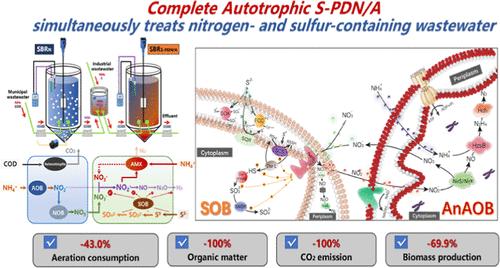Autotrophic Sulfur-Driven Partial Denitrification as a Sustainable Nitrite Supply Pathway for Anammox: Insights on Enhanced Nitrogen Removal and Microbial Synergies
引用次数: 0
Abstract
Anaerobic ammonia oxidation (Anammox) has garnered growing attention as an energy-efficient bioprocess. However, the sustainable provision of nitrite remains a crucial challenge. This study aimed to assess a promising alternative to existing partial nitrification- and heterotrophic partial denitrification (PDN)-based Anammox processes by substituting the nitrite supply with autotrophic sulfur-driven PDN. After 200 days, the desirable nitrogen removal efficiency of 96.1% was obtained in the S-PDN coupling Anammox process (S-PDN/A) with a high-quality effluent total nitrogen of 3.1 mg N/L. Additional experiments identified S-PDN/A as a stepwise reaction with generated S0 as an intermediate. Initially, S2– was oxidized to S0 [21.2 mg of S/(g of SS·h)], coupled with ultrafast denitrification [NO3– → N2, 3.9 mg of N/(g of SS·h)]. Subsequently, S0 served as an electron donor for S-PDN (NO3– → NO2–), efficiently facilitating Anammox as the dominant nitrogen removal pathway contributing up to 71.0% with a reaction rate of 1.7 mg N/(g SS·h). Distinct from reported prevalence of Candidatus brocadia in the Anammox technology for low-strength wastewater treatment, Candidatus kuenenia (0.12% → 3.4%) unexpectedly triumphed due to unique ecological niche provided by S-PDN. S-PDN/A offers fresh insights into Anammox application, enabling a potential reduction of up to 100% in organics demand, 43.0% savings in aeration energy consumption, and 69.9% decrease in biomass generation when compared to conventional bioprocesses.

自养硫驱动部分反硝化作为 Anammox 的可持续亚硝酸盐供应途径:关于强化脱氮和微生物协同作用的见解
厌氧氨氧化(Anammox)作为一种高能效的生物工艺,已经引起了越来越多的关注。然而,亚硝酸盐的可持续供应仍然是一个关键挑战。本研究旨在评估一种替代现有的部分硝化和异养部分反硝化(PDN)为基础的 Anammox 过程的可行方法,即用自养硫驱动的 PDN 替代亚硝酸盐供应。200 天后,S-PDN 耦合 Anammox 工艺(S-PDN/A)的理想脱氮效率达到 96.1%,高质量出水总氮为 3.1 毫克/升。其他实验表明,S-PDN/A 是一种以生成的 S0 为中间体的分步反应。最初,S2- 被氧化成 S0 [21.2 毫克 S/(克 SS-h)],同时发生超快反硝化作用 [NO3- → N2,3.9 毫克 N/(克 SS-h)]。随后,S0 成为 S-PDN(NO3- → NO2-)的电子供体,有效地促进了 Anammox,成为主要的脱氮途径,脱氮率高达 71.0%,反应速率为 1.7 毫克 N/(克 SS-小时)。与已报道的在低浓度废水处理的 Anammox 技术中普遍存在的 Candidatus brocadia 不同,由于 S-PDN 提供了独特的生态位,Candidatus kuenenia(0.12% → 3.4%)出人意料地取得了胜利。S-PDN/A 为 Anammox 的应用提供了新的视角,与传统生物工艺相比,S-PDN/A 可使有机物需求量减少达 100%,曝气能耗降低 43.0%,生物质产生量减少 69.9%。
本文章由计算机程序翻译,如有差异,请以英文原文为准。
求助全文
约1分钟内获得全文
求助全文

 求助内容:
求助内容: 应助结果提醒方式:
应助结果提醒方式:


